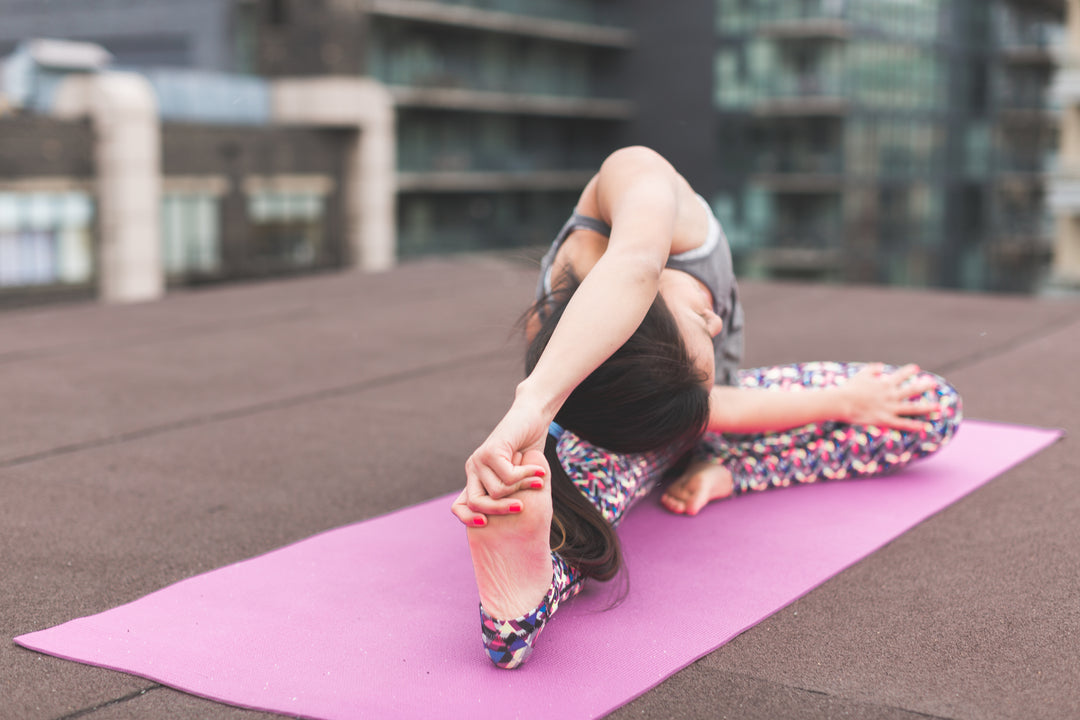Yoga for Running: Can one help the other?
At first glance, running and Yoga seem like polar opposites: one slow and methodical, the other Yoga. In reality, however, they are actually complementary practices that can significantly boost your overall fitness and well-being. This article explores how combining these two activities can enhance your running performance and, maybe more importantly, help prevent injuries.
As we’ve explored previously, Yoga is an ancient practice originating in India. It focuses on physical postures, breathing techniques, and meditation and is known for improving flexibility, strength, and mental focus.
We all know what running is—it’s really the opposite of Yoga. It’s a high-impact cardiovascular exercise that builds endurance and burns calories efficiently.
When you merge these two disciplines, you create a powerful yin and yang. Yoga can address many of the physical challenges runners face, such as tight muscles, limited range of motion, and poor posture. Many of you reading this will know that when these things are taken care of, efficiency improves.
Not to mention the mental health benefits that can improve your running mindset and help you push through tough training sessions or races.
Here, we’ll delve into the specific ways Yoga can benefit runners, when to practice Yoga in relation to your runs, and which poses can help strengthen key areas like your knees. We’ll also provide practical tips on how to integrate Yoga into your running routine effectively.
Whether you’re a seasoned ultra-runner or a casual jogger, adding Yoga to your training regimen could be critical to unlocking your running potential. Let’s explore how these two practices can work together to make you a stronger, more balanced, and more resilient runner.
Benefits of Yoga for Runners
If you’re contemplating adding Yoga to your routine, you’ll be interested in hearing the benefits of Yoga for runners.
Is Yoga good for running?
In short, yes. Yoga offers numerous benefits that significantly improve your running performance and overall experience. Here’s how:
Improved flexibility and range of motion
Yoga stretches and lengthens muscles, tendons, and ligaments. This increased flexibility can lead to a more efficient running stride and reduced risk of injury. Typical areas that benefit include hamstrings, hip flexors, and calves—all crucial for runners. It’s perfect if you spend much of your sedentary time at a desk or workstation.
Enhanced core strength and stability
Many yoga poses engage the core muscles, building strength in your abdomen, lower back, and pelvis. It can take longer, but a strong core improves posture and stability while running, leading to better form over long distances. When things get tough, you can keep your form better for longer.
Better breathing techniques
Yoga emphasises deep, controlled breathing. These techniques can increase lung capacity and improve oxygen efficiency, helping you maintain a steady breath during runs. Proper breathing can also help manage stitches and prevent early fatigue.
Increased body awareness and balance
Regular Yoga enhances proprioception—your body’s ability to sense its position in space. This improved body awareness can help you maintain proper form while running, reducing the risk of injuries caused by poor alignment or overstriding. This is particularly useful when running trails and placing your feet quickly over uneven terrain.

Mental benefits of Yoga for runners
Another reason why a runner might consider doing Yoga is that the advantages extend beyond the physical realm:
Stress reduction and focus
Yoga’s meditative aspects can significantly reduce stress and anxiety. This mental calmness can be particularly beneficial before races or challenging training sessions. The focus cultivated in Yoga can help you maintain concentration during long runs or when pushing through difficult sections of a race.
Mindfulness and running performance
Yoga teaches mindfulness - the practice of being present in the moment. This skill can be invaluable for runners, helping you tune into your body’s signals during a run. You’ll be better equipped to pace yourself, recognise early signs of fatigue or injury, and push through mental barriers when they inevitably arise. Mindfulness can also enhance the enjoyment of your runs, allowing you to appreciate running itself rather than solely focusing on goals or outcomes. That doesn’t sound too bad, right?

When to Practice Yoga: Pre or Post Running?
Doing your yoga practice in relation to your runs can significantly impact its benefits. Let’s explore the advantages of pre-run and post-run Yoga and how to find the right balance for your needs.
Pre-run Yoga
Before you run, you can use or incorporate Yoga into your actions in several ways.
Gentle warm-up sequences
A short yoga routine before running can effectively warm your muscles and joints. Focus on gentle movements that gradually increase your heart rate and body temperature. Sun salutations or a series of flowing poses can be particularly effective.
Dynamic stretching
Pre-run Yoga should emphasise dynamic stretches that move your joints through their full range of motion. This type of stretching improves flexibility while preparing your body for the demands of running. Avoid deep, static stretches, which might decrease muscle power and performance.
Mental preparation
A brief pre-run yoga session can help centre your mind and set intentions for your run. This mental preparation can boost focus and motivation, potentially leading to a more enjoyable and effective running session.
Post-run Yoga
Similarly, after your run, you can add Yoga to your activities in a few ways.
Cool-down and recovery
Yoga after running is an excellent cool-down activity. It helps gradually lower your heart rate and body temperature, easing your body back to its resting state. This transition can help reduce post-run stiffness and soreness.
Static stretching
Unlike pre-run Yoga, post-run sessions can include deeper, static stretches. These activities help improve overall flexibility and can target areas that tighten during running, such as hip flexors, hamstrings, and calves. Hold each stretch for 30 seconds to 2 minutes for maximum benefit.
Relaxation and muscle tension release
Post-run Yoga provides an opportunity to release tension built up during your run. Restorative poses and gentle twists can help alleviate muscle tightness and promote relaxation, enhancing recovery and reducing the risk of post-run stiffness.
Balancing both: finding the right approach for you
The ideal timing for yoga practice varies among runners. Consider these factors when deciding:
Time constraints: When short on time, choose either pre or post-run Yoga based on your primary goal (preparation or recovery).
Running intensity: A brief pre-run warm-up might be sufficient for high-intensity runs or races, saving a more extended session for afterwards.
Personal preference: Some runners find pre-run yoga energising, while others prefer it for post-run relaxation. Experiment to see what feels best for you.
Alternating approach: You might opt for short pre-run sessions on some days and longer post-run practices on others. Balancing both, if possible, will benefit you.
Remember, consistency is key. Whether you choose pre-run, post-run, or a combination of both, regular yoga practice will yield the most significant benefits for your running performance and overall well-being.

Common Mistakes and How to Avoid Them
When integrating Yoga into your running routine, being aware of potential pitfalls is important. Here are some common mistakes runners make with Yoga and how to avoid them:
Overstretching
Many runners, eager to increase flexibility, push too hard in yoga poses. This can lead to muscle strains or more serious injuries.
How to avoid:
1. Listen to your body. Stretch to the point of mild tension, not pain.
2. Warm up properly before attempting deep stretches.
3. Focus on gradual progress rather than forcing immediate results.
4. Be especially cautious with hamstrings and lower back - areas often tight in runners.
Neglecting strength-building poses
Some runners focus solely on stretching in Yoga, overlooking the strength-building aspects. This imbalance can limit the overall benefits of your running.
How to avoid:
1. Incorporate poses that build strength, such as warrior poses, chair pose, and planks. Planks are great for your core; most runners will already know this.
2. Balance your practice between flexibility and strength work.
3. Pay particular attention to core-strengthening poses, which are crucial for running form.
4. Don’t shy away from challenging poses - they often offer the most strength benefits.
Inconsistent practice
Many runners practice Yoga sporadically, which limits its effectiveness in improving running performance and preventing Don’ties.
How to avoid:
1. Set a regular yoga schedule, even if it’s just 10-15 minutes a few times a week.
2. Integrate short yoga sessions into your warm-up or cool-down routines.
3. Use rest days from running as opportunities for longer yoga practices.
4. Remember that consistency is critical for maximum benefit - regular, moderate practice is more beneficial than occasional intense sessions.
By avoiding these common mistakes, you’ll ensure your yoga practice complements and enhances your running rather than potentially hindering it. Remember, Yoga is a practice - it’s about progress, not perfection. Be patient with yourself and enjoy the journey of integrating Yoga into your running lifestyle.

Yoga Poses to Strengthen Knees for Running.
Knee strength is one of the most significant factors stopping people from running. All runners must take care of themselves, but if you are worried about the condition of your knees, you must do as much as you can to protect yourself. Yoga can strengthen your knee muscles, helping you run with greater confidence.
Anatomy of the knee and common running-related issues
The knee is a complex joint involving the femur, tibia, and patella, connected by ligaments and supported by muscles. Runners often face issues such as:
- Runner’s knee (patellofemoral pain syndrome)
- IT band syndrome
- Meniscus tears
- Patellar tendinitis
These issues often stem from muscle imbalances, overuse, or poor running form. Yoga can help address these by strengthening muscles and improving alignment. We’ll briefly touch on types of yoga movements you can use, but it is best to seek guidance from a yoga expert.
Specific yoga poses for knee strength and stability
Warrior poses
- Warrior I, II, and III engage the quadriceps, hamstrings, and glutes.
- They improve leg strength and knee stability.
- Hold each pose for 30-60 seconds, focusing on keeping the front knee aligned over the ankle.
Chair pose
- Strengthens the quadriceps, which support the knee joint.
- Improves overall leg strength and stability.
- Hold for 30-60 seconds, ensuring knees don’t extend beyond toes.
Lunges
- Low lunge and Crescent lunge strengthen legs and improve balance.
- They target muscles around the knee, enhancing stability.
- Perform 5-10 breaths per side, maintaining proper knee alignment.
Bridge Pose (Setu Bandhasana)
- Strengthens hamstrings, glutes, and lower back.
- Helps correct muscle imbalances that can lead to knee issues.
- Hold for 30-60 seconds, focusing on engaging glutes and hamstrings.
Proper alignment and form to protect knees during yoga practice
With proper preparation, you can significantly enhance the benefits you enjoy from Yoga.
- Knee-ankle alignment: In standing poses, ensure your knee tracks over your second toe.
- Engage supporting muscles: Always activate your quadriceps and core to support your knees.
- Avoid hyperextension: Keep a micro-bend in your knees during straight-leg poses.
- Mind your limits: Don’t force your knees into uncomfortable positions. Use props if needed.
- Gradual progression: Build strength slowly, especially if you have a history of knee issues.
- Balanced practice: Include poses that strengthen both the front and back of your legs.
Yoga can significantly benefit knee health, but listening to your body is crucial. If you experience knee pain during practice, back off and consider consulting a physiotherapist or qualified yoga instructor for personalised guidance. Proper form is key to reaping the benefits of these poses while protecting your knees.

Integrating Yoga into Your Running Routine
If you want to add Yoga to your running routine, please consider these points.
Frequency and duration recommendations
1. Aim for at least 2-3 yoga sessions per week.
2. Include short pre and post-run sequences in your daily running routine.
3. Dedicate one longer session (30-60 minutes) per week for a full practice.
4. Start with shorter sessions and gradually increase duration as you build strength and flexibility.
Balancing Yoga and running in your training schedule
1. Use Yoga as an active recovery method on rest days from running.
2. Incorporate pre-run sequences before easy runs and post-run sequences after all runs.
3. Schedule your longer yoga session on a day when you won’t be doing a hard or long run.
4. During peak training periods, focus on gentler yoga practices to avoid overexertion.
Listening to your body and adapting your practice
1. Pay attention to how your body feels before, you’re, and after yoga practice.
2. Modify poses as needed, using props or alternative poses if something doesn’t feel right.
3. Be willing to adjust your yoga practice based on your running schedule and how your body feels.
4. If you’re experiencing persistent pain or discomfort, consult a healthcare professional or qualified Yoga instructor.
5. Remember that Yoga should complement your running, not hinder it. If you feel overly fatigued, scale back your device.
By thoughtfully integrating Yoga into your running routine, you can enhance your performance, reduce injury risk, and enjoy a more balanced approach to your training. Remember, consistency is critical, but so is flexibility in your approach. Depending on your training schedule, your body’s needs may change often, so stay attuned and adjust accordingly.
Resources:
Yoga for runners: https://www.yogaforrunners.com/
Yoga and mindfulness: https://www.sciencedirect.com/science/article/abs/pii/S107772290800body’s0 Yoga Poses to Strengthen Your Knees: https://liforme.com/blogs/blog/10-yoga-poses-to-strengthen-your-knees




